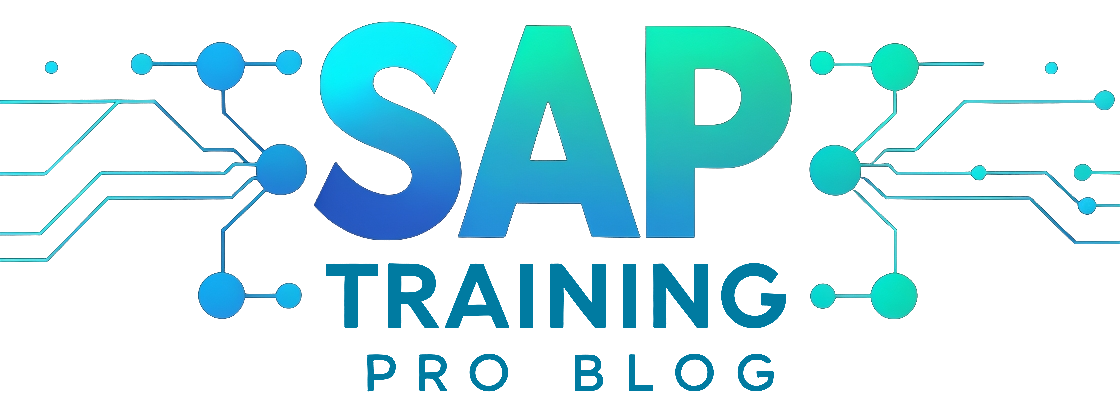Unlocking the Potential: Unraveling SAP Market Trends

This article delves into the dynamic world of the SAP market, shedding light on the latest trends that hold immense potential for businesses. As technology continues to advance at a rapid pace, it is crucial for organizations to stay informed about the key factors shaping the future of SAP technology.
Table Of Content
- Cloud Migration: Embracing the Future
- AI Integration: Revolutionizing SAP
- Intelligent Automation: Streamlining Processes
- Robotic Process Automation (RPA): Enhancing Efficiency
- Cognitive Computing: Unleashing Insights
- Predictive Analytics: Shaping the Future
- Data Security: Safeguarding SAP Systems
- Cybersecurity Measures: Fortifying SAP
- Compliance and Governance: Navigating Regulatory Requirements
- User Experience: Enhancing SAP Adoption
- Mobile Accessibility: Anytime, Anywhere
- Personalization and Simplification: Tailoring SAP Experience
One of the prominent trends in the SAP market is the increasing adoption of cloud-based systems. Businesses are recognizing the benefits of migrating their SAP systems to the cloud, such as enhanced scalability, flexibility, and cost-efficiency. The cloud offers a platform for seamless integration and access to data from anywhere, empowering organizations to optimize their operations and drive growth.
In addition to cloud migration, the integration of artificial intelligence (AI) is revolutionizing the SAP landscape. AI-powered technologies, such as intelligent automation and predictive analytics, are unlocking new possibilities for businesses. By automating processes, reducing manual effort, and harnessing valuable insights from data, organizations can enhance their SAP capabilities and make data-driven decisions.
By exploring these trends in the SAP market, businesses can unlock the potential that lies within and stay ahead of the curve in an ever-evolving digital landscape.
Cloud Migration: Embracing the Future
As businesses continue to evolve and adapt to the ever-changing digital landscape, cloud migration has emerged as a prominent trend in the SAP market. More and more companies are recognizing the benefits of moving their SAP systems to the cloud, unlocking a world of opportunities and possibilities.
One of the key advantages of cloud adoption is increased scalability. With traditional on-premises infrastructure, businesses often face limitations when it comes to scaling their SAP systems. However, by migrating to the cloud, organizations can easily scale their resources up or down based on their needs, allowing for greater flexibility and agility.
Flexibility is another crucial benefit of cloud migration. With SAP systems in the cloud, businesses can access their data and applications from anywhere, at any time, using any device. This level of accessibility empowers employees to work remotely, collaborate seamlessly, and make informed decisions on the go.
Cost-efficiency is yet another advantage of embracing the cloud. By moving their SAP systems to the cloud, businesses can reduce their infrastructure costs, eliminate the need for on-premises hardware and maintenance, and pay for only the resources they use. This shift to an operational expenditure model allows organizations to optimize their IT budgets and allocate resources more effectively.
In conclusion, cloud migration is revolutionizing the SAP market, offering businesses increased scalability, flexibility, and cost-efficiency. By embracing the future of cloud adoption, organizations can unlock the full potential of their SAP systems and stay ahead in today’s competitive landscape.
AI Integration: Revolutionizing SAP
AI Integration: Revolutionizing SAP
Artificial intelligence (AI) is revolutionizing the SAP landscape, transforming the way businesses operate and unlocking new possibilities. With AI, businesses can leverage intelligent automation and predictive analytics to enhance their SAP capabilities and drive growth.
Intelligent automation is one of the key areas where AI is making a significant impact. By automating repetitive tasks and streamlining processes, businesses can reduce manual effort and improve efficiency. This allows employees to focus on more strategic initiatives, ultimately driving productivity and innovation.
Predictive analytics is another area where AI is revolutionizing SAP. By leveraging advanced algorithms and machine learning, businesses can analyze vast amounts of data to make data-driven decisions. Predictive models provide valuable insights and enable businesses to anticipate customer behavior, optimize operations, and gain a competitive edge.
The transformative power of AI in enhancing SAP capabilities is undeniable. As businesses continue to embrace AI integration, they can unlock new opportunities, improve efficiency, and stay ahead in the competitive SAP market.
Intelligent Automation: Streamlining Processes
Intelligent automation is a game-changer in the world of SAP processes. By leveraging advanced technologies such as robotic process automation (RPA) and machine learning, businesses are streamlining their operations, reducing manual effort, and improving overall efficiency.
With intelligent automation, repetitive and time-consuming tasks are automated, freeing up valuable resources and allowing employees to focus on more strategic initiatives. This not only increases productivity but also enhances the accuracy and consistency of SAP processes.
Real-world examples abound of how businesses are harnessing the power of automation to drive productivity. For instance, companies are using RPA to automate invoice processing, reducing errors and processing time. Others are leveraging machine learning algorithms to automate data analysis, enabling faster and more accurate decision-making.
Intelligent automation is not just a buzzword; it is a proven strategy for streamlining SAP processes and achieving tangible results. By embracing automation, businesses can unlock new levels of efficiency and productivity, giving them a competitive edge in today’s fast-paced business landscape.
Robotic Process Automation (RPA): Enhancing Efficiency
Robotic Process Automation (RPA) plays a crucial role in SAP systems, revolutionizing the way businesses operate. By automating repetitive tasks and processes, RPA enables organizations to enhance efficiency and productivity. With RPA in place, employees can focus on more strategic initiatives, driving innovation and growth.
One of the key benefits of RPA is its ability to automate mundane and repetitive tasks, such as data entry and invoice processing. By leveraging software robots, organizations can streamline these processes, reducing manual effort and minimizing errors. This not only saves time but also frees up valuable resources, allowing employees to concentrate on higher-value activities that require creativity and critical thinking.
RPA also offers scalability and flexibility, making it an ideal solution for businesses of all sizes. It can be easily implemented and integrated with existing SAP systems, providing a seamless automation experience. With RPA, organizations can achieve faster turnaround times, improved accuracy, and increased operational efficiency.
In conclusion, Robotic Process Automation (RPA) is a game-changer in the SAP market, enhancing efficiency and enabling organizations to optimize their operations. By automating repetitive tasks, RPA frees up resources and empowers employees to focus on more strategic initiatives, driving innovation and growth.
Cognitive Computing: Unleashing Insights
Uncover the potential of cognitive computing in SAP and witness the power of machine learning algorithms and natural language processing. With the ability to analyze vast amounts of data, cognitive computing is revolutionizing the way businesses unlock valuable insights.
Imagine a world where SAP systems can not only process data but also understand and interpret it. Cognitive computing brings this vision to life by enabling machines to learn from patterns, make predictions, and extract meaningful information from unstructured data.
By harnessing the capabilities of machine learning algorithms, SAP systems can uncover hidden patterns, trends, and correlations, providing businesses with valuable insights that can drive decision-making and strategy. Natural language processing further enhances this process by enabling SAP systems to understand and interpret human language, making it easier to extract insights from text-based data.
With cognitive computing, businesses can gain a competitive edge by leveraging the power of data-driven insights. From predicting customer behavior to optimizing business processes, the potential applications of cognitive computing in SAP are vast and promising.
Predictive Analytics: Shaping the Future
Discover how predictive analytics is transforming SAP systems into intelligent platforms. With the power of predictive models, businesses are now able to make data-driven decisions and gain a competitive edge in the market.
Predictive analytics leverages historical data and statistical algorithms to forecast future outcomes and trends. By analyzing vast amounts of data, businesses can identify patterns, detect anomalies, and make accurate predictions. This allows them to anticipate customer behavior, optimize processes, and mitigate risks.
By harnessing the potential of predictive analytics in SAP systems, businesses can optimize their operations and drive growth. They can identify opportunities for cost savings, improve supply chain management, and enhance customer satisfaction. With real-time insights and predictive models, businesses can make proactive decisions and stay ahead of the competition.
Data Security: Safeguarding SAP Systems
Data security is of utmost importance in the SAP market, as businesses increasingly rely on SAP systems to store and manage sensitive data. With the rise of cyber threats, it is crucial for organizations to adopt robust security measures to safeguard their SAP systems and protect the confidentiality and integrity of their data.
One of the latest trends in data security is the implementation of multi-factor authentication (MFA). By requiring users to provide multiple forms of identification, such as a password and a fingerprint, MFA adds an extra layer of security to SAP systems, making it more difficult for unauthorized individuals to gain access.
Another best practice in data security is the regular monitoring and analysis of system logs. By analyzing system logs, organizations can identify any suspicious activities or potential security breaches and take immediate action to mitigate the risks. This proactive approach helps in detecting and preventing security incidents before they escalate.
Furthermore, encryption plays a vital role in safeguarding sensitive data in SAP systems. By encrypting data at rest and in transit, organizations can ensure that even if the data is intercepted, it remains unreadable and unusable to unauthorized individuals. Additionally, access control mechanisms, such as role-based access control (RBAC), help in limiting access to sensitive data, ensuring that only authorized personnel can view or modify it.
In conclusion, data security is a critical aspect of SAP systems. By staying updated with the latest trends and implementing best practices, organizations can effectively safeguard their SAP systems from cyber threats, maintaining the confidentiality and integrity of their sensitive data.
Cybersecurity Measures: Fortifying SAP
In today’s digital landscape, cybersecurity is of paramount importance for businesses utilizing SAP systems. Protecting sensitive data from unauthorized access and breaches is crucial to maintaining the integrity and confidentiality of critical information. To fortify SAP systems against potential threats, businesses should implement a range of cybersecurity measures.
One essential measure is encryption, which involves encoding data to make it unreadable to unauthorized individuals. By encrypting data at rest and in transit, businesses can ensure that even if it is intercepted, it remains secure. Additionally, access control is crucial in preventing unauthorized users from gaining entry to SAP systems. By implementing strong authentication methods, such as multi-factor authentication, businesses can verify the identity of users and restrict access to sensitive data.
Furthermore, businesses should regularly update and patch their SAP systems to address any vulnerabilities that may arise. This helps to prevent potential exploits and ensures that the system is equipped with the latest security enhancements. Implementing firewalls and intrusion detection systems can also provide an additional layer of protection by monitoring network traffic and identifying any suspicious activities.
By adopting these cybersecurity measures, businesses can fortify their SAP systems and safeguard critical data from unauthorized access and breaches. It is crucial to stay vigilant and proactive in the ever-evolving landscape of cybersecurity to protect against emerging threats and ensure the security of SAP systems.
Compliance and Governance: Navigating Regulatory Requirements
Compliance and governance are crucial aspects of managing SAP systems in today’s business landscape. As organizations rely more on SAP technology, they must navigate a complex web of regulatory requirements to ensure adherence to industry standards and mitigate risks.
Businesses face numerous challenges in maintaining compliance and governance in their SAP systems. One of the main challenges is keeping up with the ever-evolving regulatory landscape. As new regulations are introduced, organizations must quickly adapt their SAP systems to remain compliant. Failure to do so can result in severe penalties and reputational damage.
To navigate these challenges, businesses need to stay informed about the latest regulations impacting the SAP market. They must also develop robust strategies to ensure compliance. This includes implementing internal controls, conducting regular audits, and monitoring system activity to detect any potential compliance violations.
Furthermore, organizations should consider leveraging automated compliance solutions to streamline the compliance process. These solutions can help identify and address compliance issues in real-time, reducing the risk of non-compliance and enabling businesses to focus on their core operations.
User Experience: Enhancing SAP Adoption
User experience (UX) plays a crucial role in driving the adoption of SAP systems. As businesses recognize the significance of seamless and intuitive interfaces, the focus on enhancing user experience has intensified. By prioritizing UX, organizations can ensure that employees are able to effectively utilize SAP systems, leading to increased productivity and overall satisfaction.
To enhance user experience, businesses are leveraging the latest trends and tools in UX design. One such trend is the use of responsive design, which ensures that SAP systems are accessible and optimized for different devices, including mobile phones and tablets. This allows users to access SAP functionalities anytime, anywhere, providing them with greater flexibility and convenience.
In addition to responsive design, personalization is another key aspect of enhancing user experience. Businesses are customizing SAP interfaces to meet the specific needs and preferences of users, tailoring the system to their individual requirements. This not only improves user satisfaction but also increases productivity by simplifying complex processes and reducing the time and effort required to perform tasks.
To further enhance usability, SAP users are benefiting from the use of advanced tools and technologies. These include interactive dashboards, intuitive navigation menus, and contextual help features. These tools provide users with a more intuitive and efficient experience, allowing them to easily navigate through the system, access relevant information, and perform tasks with ease.
Overall, by prioritizing user experience and adopting the latest UX trends and tools, businesses can drive the adoption of SAP systems and maximize the benefits they offer. Improved usability, productivity, and overall satisfaction with SAP systems can lead to increased efficiency and success for organizations in the ever-evolving digital landscape.
Mobile Accessibility: Anytime, Anywhere
Mobile accessibility is playing a crucial role in the world of SAP systems. With the increasing use of smartphones and tablets, businesses are recognizing the need to provide users with seamless access to SAP functionalities on the go. This has led to the development of mobile apps and responsive designs that cater to the needs of users who are constantly on the move.
By leveraging mobile apps, businesses are empowering their workforce to access SAP systems anytime and anywhere. Whether it’s checking inventory levels, approving purchase orders, or analyzing sales data, employees can now perform these tasks on their mobile devices, eliminating the need for them to be tied to their desks.
Responsive design is another key aspect of mobile accessibility in SAP systems. It ensures that the user interface of SAP applications adapts to different screen sizes and resolutions, providing an optimal viewing experience across various devices. This means that whether a user is accessing SAP on a smartphone, tablet, or laptop, they can enjoy a consistent and user-friendly interface.
In conclusion, mobile accessibility is revolutionizing the way businesses interact with SAP systems. By embracing mobile apps and responsive design, companies are enabling their users to access SAP functionalities anytime, anywhere, resulting in increased productivity and efficiency.
Personalization and Simplification: Tailoring SAP Experience
Discover how personalization and simplification are revolutionizing the SAP user experience. In today’s fast-paced business environment, businesses are realizing the importance of customizing SAP interfaces to meet their unique needs. By tailoring the SAP experience, organizations can enhance user satisfaction and productivity.
One of the key aspects of personalization is simplifying complex processes. SAP systems can often be overwhelming with their multitude of features and functionalities. However, businesses are now streamlining these processes by removing unnecessary steps and creating intuitive interfaces. This simplification not only improves user satisfaction but also increases efficiency by reducing the time and effort required to complete tasks.
Moreover, personalization allows businesses to adapt SAP interfaces to match their specific workflows and preferences. By customizing the layout, design, and functionality of SAP systems, organizations can create a user-friendly environment that aligns with their unique business processes. This level of personalization fosters a sense of ownership and familiarity, empowering users to navigate the system with ease and confidence.
By embracing personalization and simplification, businesses can unlock the full potential of SAP technology. Improved user satisfaction and productivity translate into tangible benefits such as increased employee engagement, streamlined operations, and ultimately, better business outcomes.


